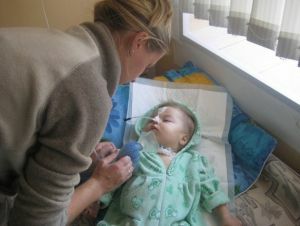 Alexander's disease is a very rare form of leukodystrophy.
Alexander's disease is a very rare form of leukodystrophy.
This is one of the neurodegenerative diseases of the nervous system. With the development of this ailment , white matter is destroyed - myelin .
This component is necessary for the body to form the myelin sheath of nerve fibers, as well as for the transmission of nerve impulses.
In the disease, there are combined disorders in the work of neurons and immune cells.
Content
- disease forms
- potential
- risk group The causes of the disease
- Diagnosing
- disease Difficulty identifying symptoms
- Neonatal form
- first years
- life Juvenile period
- Symptoms in adults
- symptoms Treatment
- disappointing conclusion
disease forms
Similarly disease more often affects children. Alexander's disease usually is lethal within 10 years after the first symptoms of appeared.
At the moment, there are three forms of the disease:
- adult;
- is a juvenile;
- is infantile.
In addition, specialists recognize the neonatal form. In this case, the disease occurs in a child who is in the womb during the gestation period. Each of the forms has an exclusively genetic basis.
Potential risk group
The main category of people who suffer from this disease include children with a genetic predisposition. Each recorded case ended in a lethal outcome.
At the moment there are not many cases of Rosenthal's disease. It is for this reason that the disease is not yet fully understood. As research shows, the ailment can appear in a person in any geographical location, of any gender and race.
Causes of
disease development Scientists have proved that Alexander leukodystrophy develops as a result of changes occurring in the 17 chromosome and having a mutational character. 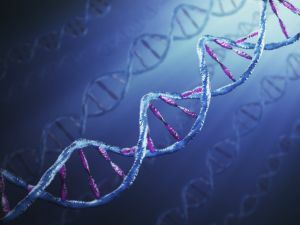
The gene is located on the long arm of this particular chromosome. With violations in it, acidic glial protein is destroyed.
However, there is a small percentage of people suffering from this disease, in which the gene in good order. Unfortunately, other causes of the development of Alexander's disease are still unknown.
In addition to this study, it has been shown that such changes in chromosome 17 are not inherited. They arise spontaneously in the formation of the child's genetic data.
This proves that none of the parents are carriers of such a mutational gene.
The probability of re-birth of a child with similar deviations is zero. Scientists suggest that such changes can occur during the formation of spermatozoa on the paternal chromosome.
However, these mutations are completely independent of age.
A special role in the development of nerve cells is played by acidic protein - GFAP.However, the altered gene provokes the accumulation in the cells of the neuroglia, which participate in carrying out in the form of impulses of nerve signals, more protein with a broken structure.
In addition, glial tissue cells provide all neurons with the necessary useful components. In other words, their livelihoods are supported.
In the presence of Alexander's disease in the patient in acidic protein there is a rapid accumulation of nodules - Rosenthal's Fibers. Subsequently, they interfere with the passage through the astrocyte of impulses, which leads to violations in the work of the entire central nervous system.
Diagnosis of the disease
The primary indicators for diagnosing are the increase in the size of the patient's head.
Specialists are obliged to conduct a series of examinations of the patient.
For this, CT, magnetic resonance imaging is usually used. In addition, it is necessary to conduct a series of tests that will help identify possible diseases from the leukodystrophic series.
The doctor can make the final diagnosis only after studying the results and the blood test, which is obliged to identify mutations in the DNA of the patient, and also to identify the acidic glial protein.
Of course, the last point even in the absence or presence of an altered protein does not guarantee the accuracy of the data and does not confirm that it is Alexander's disease.
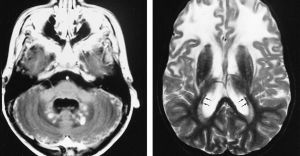 Often with negative test results after dissection, the patient is found to completely destroy myelin or the fiber of Rosenthal.
Often with negative test results after dissection, the patient is found to completely destroy myelin or the fiber of Rosenthal.
It should be noted that such nodules can severely damage the subcortical part of the brain, as well as the spinal cord. The fibers surround the capillaries, touching the soft shell of the brain.
Difficulty detecting the symptoms of
Because the disease is rare, it is very difficult to examine in detail, and most importantly, to identify its symptoms. In addition, for every form of ailment there are different signs that depend on the conditions of the course of the disease.
Neonatal form
If the change in the chromosome occurred in neonatal form in the womb, the infant's death occurs during the first year of life.
In this case, children are born immediately with cerebral edema. Of course, intracranial pressure is significantly increased and there is a stop in the child's nervous development.
The first years of life
An infantile form of the disease usually occurs in the first few years of a child's life.
Signs of Alexander's disease in this case is a delay in the physical and psychological development, which ultimately leads to complete asocialization.
Juvenile period
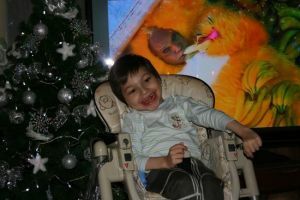
In the photo a child with alexander disease
Approximately 20% of patients suffer from a juvenile form of a disease that occurs usually up to 10 years.
In this case, the patient may experience shortness of breath, violation of swallowing reflexes and correct speech, intellectual degradation, loss of memory.
In this case, a strong damage occurs on the brain stem. Gradually myelin is destroyed.
Signs in adults
As for the adult form, it varies greatly in symptoms. To the aforementioned signs of Alexander's disease it is worth adding an involuntary movement of the eyeballs.
This indicates a delay in the mental development of the patient. In this case, the patient often suffers, in the morning especially, from vomitive impulses.
 Severe disease that affects children - perinatal encephalopathy. How to ease the suffering of the child, find out in our article.
Severe disease that affects children - perinatal encephalopathy. How to ease the suffering of the child, find out in our article. If a person is diagnosed with cerebellar ataxia, then he loses the ability to move normally and keep his balance. Features of treatment of the disease and its prevention.
Treatment of symptoms
Unfortunately, modern medicine does not have in its arsenal an effective drug against Alexander's disease. It is likely that the future in this direction depends on the development of genetic engineering.
After the diagnosis, the patient is prescribed symptomatic treatment that can significantly alleviate the patient's condition and prolong his life:
- Neuroleptics are used to reduce involuntary movements of , for example, Azaleptin, Haloperidol and others.
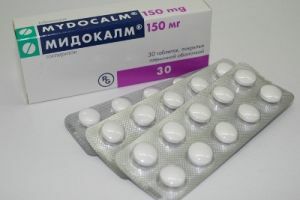
- In epileptic seizures of , anticonvulsants may be prescribed, for example, Sibazon, Valproate and the like.
- When spasticity of muscles use muscle relaxants, for example, Midokalm, Sirdalud, Baclofen.
Special tools may be used for movement.
In the peak of the disease the patient can only move in a wheelchair. In terminal stages the patient needs extraneous care.
Disappointing output
Rosental's disease is a rare, genetic disease. An expanded clinical picture in this case is represented by coordinative, motor impairments, as well as problems related to food intake and speech.
Most people with a similar disease live about 10 years. The most accurate method of diagnosing an ailment is genetic. As for the methods of treatment, they are under development.
At the moment, the patients are assisted by means aimed at the removal of symptoms.



